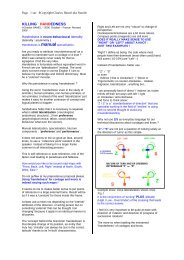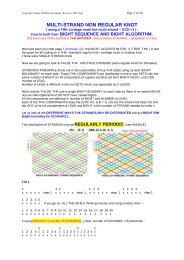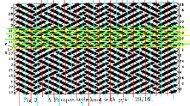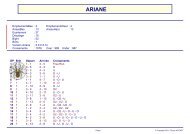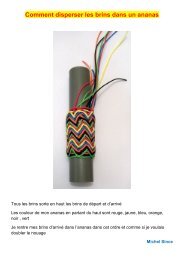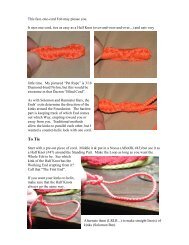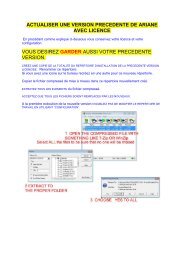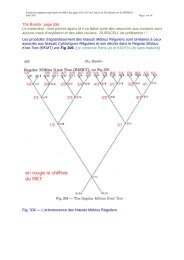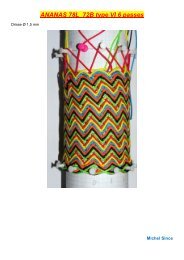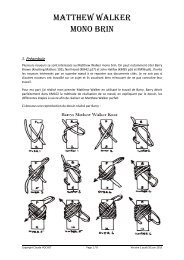a 36 pages pdf available for download - Charles HAMEL - Free
a 36 pages pdf available for download - Charles HAMEL - Free
a 36 pages pdf available for download - Charles HAMEL - Free
You also want an ePaper? Increase the reach of your titles
YUMPU automatically turns print PDFs into web optimized ePapers that Google loves.
<strong>Charles</strong> <strong>HAMEL</strong> – 2011 June Page 1 sur <strong>36</strong><br />
Release V1.3.1<br />
QUICK AND DIRTY EXPLORATION OF A PARTICULAR<br />
SERIES OF THK<br />
The origin of this quick and dirty trail blazing stems from a question Dominic TAYLOR posed<br />
to me ( Thank you Dear Dominic <strong>for</strong> the inspiration ) :<br />
[open quote]<br />
am interested in finding other sequences of TH like the 5x3/7x5/9x7/11x9<br />
etc sequence. Are there any others What makes it happen<br />
[end quote]<br />
As at first, quite in a hurry, a few hours from driving to Brittany and preparing the trip I<br />
somehow misunderstood and answered about enlargement so Dominic added :<br />
[open quote]<br />
They are just a family of 'starter' knots with cordage routes which are<br />
obviously related.<br />
5x3 goes to O2U1, 7x5 goes to O3U1, 9x7 goes to O4U1 &.c.<br />
What i can't see myself is any other "starter families" of sobre or casa<br />
THK. [end quote]<br />
First a remark I cannot do without making :<br />
sobre and casa linked by ‘or’ may let the readers think that both words and concepts can be<br />
equated one with the other. That is not so.<br />
sobre is a Spanish word used to state that the table of Half-Periods Coding is ‘economical in<br />
ef<strong>for</strong>t’ and specifies a lower number of moves <strong>for</strong> ‘UNDER’ passages of the cord while making<br />
the knot which crossings are predominantly ‘OVER’.<br />
A given THK can have two <strong>for</strong>ms : either one with a maximal number of ‘OVER’ crossings or<br />
one with a maximal number of ‘UNDER’.<br />
The so called ‘sobre’ is the <strong>for</strong>m with a maximum number of ‘OVER’.(or the one beginning<br />
with an OVER in case of equality)<br />
Casa (House –-House why on earth -) is a rather queer mannerism –my opinionfavoured,<br />
God may know why but not me, by one Tom HALL (hiding behind that pseudonym<br />
is one HICKEY) ; a search <strong>for</strong> originality or personal fame <br />
Anyway I find it useless beyond its gimmicky queerness even if it is blindly followed by too<br />
many without it being given much logical analyse.<br />
It is my considered opinion that this term that too many persons make a synonym <strong>for</strong> Turk’s<br />
Head Knot (THK) is better left <strong>for</strong>gotten.<br />
Casa could barely be acceptable as a label <strong>for</strong> a O1 U1 or U1 O1 coding as many knots<br />
besides THK can have it on their cordage route, but alas the so-called CASA == O1-U1 is a<br />
mistaken equivalence as exist some O1-U1 coding which nevertheless DO NOT comply with<br />
the COLUMN AND ROW coding of the THK.
<strong>Charles</strong> <strong>HAMEL</strong> – 2011 June Page 2 sur <strong>36</strong><br />
Release V1.3.1<br />
This shows what I consider to be the ill thought aspect of the equivalence CASA == O1-U1<br />
THK .<br />
So sobre and casa are two different concepts in two different logical planes so one may not<br />
equals cabbages with kings.<br />
Sobre : the ratio of OVER and UNDER in a THK<br />
Casa : a very fuzzy concept without any interest that sometimes, according to who is using it,<br />
refers to the coding pattern, sometimes is taken as a synonym of THK, sometimes as both.<br />
Polluting junk !<br />
Anyway a THK can only be O1-U1 (U1-O1) due to the Row AND Column coding ; any other<br />
coding than O1-U1 (U1-O1) on a THK cordage route makes it something entirely different<br />
from a THK.<br />
( Head Hunter K, Gaucho K, Fan K , Aztec K , AZTEC-FAN K, Samuel K <strong>for</strong> example are<br />
made on a THK cordage route but their -all different- coding are COLUMN coding but NOT<br />
Row AND Column coding ).<br />
Yet many persons ignore this FACT which has its roots in mathematical criterion and not in<br />
whimsical personal opinion.<br />
Let ‘little I’ be dogmatically clear –based on mathematics criterion- :<br />
THK should no be called casa knot or by an other name than THK or Regular Cylindrical<br />
Knots (single strand) O1-U1 and its coding should not be called other than COLUMN AND ROW<br />
coding which says that it can only be O1-U1 (U1-O1)<br />
IMPORTANT <strong>for</strong> common ground building : in this document I use<br />
*** the horizontal mandrel frame of reference used by Schaake.<br />
Knot edges or Bight edges are on the LEFT side and on the RIGHT side of the mandrel.<br />
*** the sobre <strong>for</strong>m of the THK<br />
xxxxxxxxxxxxxxxxxxxx
<strong>Charles</strong> <strong>HAMEL</strong> – 2011 June Page 3 sur <strong>36</strong><br />
Release V1.3.1<br />
The series proposed by Dominic TAYLOR:<br />
5L 3B-----7L 5B-----9L 7B…..<br />
The number of LEAD of knot with rank N is the number of BIGHT of knot with rank (N+1)<br />
SPACING = 2 STEP = 2 (Definitions are coming later on.)<br />
I never read or heard (books, web <strong>pages</strong>, <strong>for</strong>ums, private mail, conversation) anything<br />
whatsoever on *this* series of THK (I prefer the term ‘series’ to ‘sequence’ ; series as in the<br />
mathematics TAYLOR’s series or MACLAURIN’s series where there is a ‘development’ of the terms in<br />
the series) and Dominic TAYLOR’s question is the first occasion that brings my attention to it.<br />
This is no wonder, first as I certainly may not allege to have read all that has been written<br />
and second considering the level of mathematical interest or rather lack thereof, appetite <strong>for</strong><br />
theoretical exploration or rather the endemic absence of it and general level of intellectual<br />
curiosity in the world of knots tyers as can be evaluated from what can be seen in <strong>for</strong>ums<br />
and personal web <strong>pages</strong>.<br />
I have known <strong>for</strong> years about two terms in the proposed series : the 7L 5B and 9L 7B THK.<br />
They were labelled “quick start” knots by Ron EDWARDS who is IMO a far better and<br />
more interesting writer than any other author on THK can ever hope to be considered to be<br />
(save Georg Schaake and John C.Turner who must come first in any list).<br />
Quick start : there is a long run of HP with only OVER crossings be<strong>for</strong>e the first appearance<br />
of an UNDER. For practical purpose the run of OVER is considered “broken” by the first<br />
appearance of an UNDER crossing.<br />
7L 5B : 21 OVER 9 UNDER ; the first 9 crossings are OVER (9/30 = 30 %)<br />
9L 7B : 40 OVER 16 UNDER ; the first 16 crossings are OVER ( 16/56 =28.6 %)<br />
Almost one third of the knot is made be<strong>for</strong>e making the first UNDER.<br />
For professional ‘braiders’ this is of interest as “production time” is an important factor in<br />
pricing.<br />
Along this particular series successively appear, knot after knot, consistent smooth and<br />
progressive runs of ‘O’ : O1, O1, O2 O1,O2,O3, O1, O2, O3, O4,<br />
O1, O2, O3, O4, O5…..<br />
Mind that you note there are TWO perspectives to consider in the determination of the<br />
highest numbered Half-Period (HP) in which the maximum of OVER is attained :<br />
either the last HP beginning with O max or O max-1 without any U (‘isolated’ or ‘pure’ OVER)<br />
The longest run of HP with pure ‘O’ without any U.<br />
or the last HP with O max – U1 (longest run of HP beginning with ‘O x ’ ) could even be the<br />
first HP with O max – U1 if you decide ‘breaking point’ is important in there : the one of<br />
interest <strong>for</strong> the professional ‘braider’ and corresponding to the ‘quick start’. Longest run of<br />
‘O’
<strong>Charles</strong> <strong>HAMEL</strong> – 2011 June Page 4 sur <strong>36</strong><br />
Release V1.3.1<br />
17L 19B spacing =2 step=2<br />
B>L<br />
19L 17B spacing=2 step=2 L>B<br />
HP1 <strong>Free</strong> Run 1 Wrap<br />
HP2 <strong>Free</strong> Run<br />
HP3 <strong>Free</strong> Run<br />
HP4 O1<br />
HP5 O1<br />
HP6 O2<br />
HP7 O2<br />
HP8 O3<br />
HP9 O3<br />
HP10 O4<br />
HP11 O4<br />
HP12 O5<br />
HP13 O5<br />
HP14 O6<br />
HP15 O6<br />
HP16 O7<br />
HP17 O7<br />
HP18 O8<br />
HP19 O8<br />
HP20 O8<br />
HP21 O8 HP21 O8<br />
HP22 U1 – O8<br />
HP23 U1 – O8<br />
HP24 U1 – O1 – U1 – O7<br />
13L 17B spacing=4 step=2 B>L<br />
HP1 <strong>Free</strong> Run 1 Wrap<br />
HP2 <strong>Free</strong> Run<br />
HP3 <strong>Free</strong> Run<br />
HP4 O1<br />
HP5 O1<br />
HP6 O2<br />
HP7 O2<br />
HP8 O3<br />
HP9 O3<br />
HP10 O3<br />
HP11 O3 HP11 O3<br />
HP12 U1 – O3<br />
HP13 U1 – O3<br />
HP1 <strong>Free</strong> Run 1 Wrap<br />
HP2 O1<br />
HP3 O1<br />
HP4 O2<br />
HP5 O2<br />
HP6 O3<br />
HP7 O3<br />
HP8 O4<br />
HP9 O4<br />
HP10 O5<br />
HP11 O5<br />
HP12 O6<br />
HP13 O6<br />
HP14 O7<br />
HP15 O7<br />
HP16 O8<br />
HP17 O8<br />
HP18 O9 – U1<br />
HP19 O9 – U1<br />
HP20 O8 – U1 – O1 – U1<br />
17L 13B spacing=4 step=2 L>B<br />
HP1 <strong>Free</strong> Run 1 Wrap<br />
HP2 O1<br />
HP3 O1<br />
HP4 O2<br />
HP5 O2<br />
HP6 O3<br />
HP7 O3<br />
HP8 O4 – U1<br />
HP9 O4 – U1<br />
HP10 O3 – U1 – O1 – U1
<strong>Charles</strong> <strong>HAMEL</strong> – 2011 June Page 5 sur <strong>36</strong><br />
Release V1.3.1<br />
It is an immediate observation that :<br />
--- this series is of ODD LEAD ODD BIGHT THK with L>B<br />
--- SPACING between L & B numbers in any given knot in the series is equal to 2.<br />
spacing = (absolute value of L-B or | L – B | = 2)<br />
--- L in knot with rank N – L in knot with rank (N-1) = B in knot with rank N – B in knot<br />
with rank (N-1) = 2 , this will be denoted STEP. Here STEP=2<br />
--- As here STEP is of EVEN PARITY it follows that the ODD PARITY of LEAD and BIGHT will<br />
stay unchanged by the addition of “EVEN” step so we keep ODD LEAD ODD BIGHT.
<strong>Charles</strong> <strong>HAMEL</strong> – 2011 June Page 6 sur <strong>36</strong><br />
Release V1.3.1<br />
NUMBER<br />
OF LEAD<br />
L – 1 :<br />
number of<br />
crossings<br />
in a HP<br />
Max number of<br />
crossing at one go in<br />
the first term of a HP<br />
code in the series<br />
<strong>for</strong>m O-U<br />
Max number of<br />
crossing at one go in<br />
the first term of a HP<br />
code in the series<br />
<strong>for</strong>m O without any U<br />
5 4 2 1<br />
7 6 4 3<br />
9 8 6 5<br />
11 10 8 7<br />
13 12 10 9<br />
15 14 12 11<br />
17 16 14 13<br />
19 18 16 15<br />
21 20 18 17<br />
23 22 20 19<br />
25 24 22 21<br />
This series can be considered to span either from O 1 to O ((L-1)/2) or from O 1 to O ((L-1/)2)-1<br />
*** GENERAL FORMULA FOR THIS SERIES<br />
3 + (2 * n ) LEAD ( 2 * n ) + 1 BIGHT IF n lowest value is 1<br />
n=1 3 + (2*1) LEAD 1 + ( 2 * 1 ) BIGHT == 5L 3B<br />
n=2 3 + (2*2) LEAD 1 + ( 2 * 2 ) BIGHT == 7L 5B<br />
n=3 3 + (2*3) LEAD 1 + ( 2 * 3 ) BIGHT == 9L 7B<br />
5 + (2 * n ) LEAD ( 2 * (n + 2) ) - 1 ) BIGHT<br />
better 5 + (2 * n ) LEAD ( 2 * n ) + 3) BIGHT <strong>for</strong> n from 0<br />
Where ‘n’ is an integer which can take value 0 to …as large as needed.<br />
n=0 ( 5 + ( 2 * 0 ) LEAD (2 * (0 + 2) – 1 BIGHT == 5L 3B<br />
n=1 ( 5 + ( 2 * 1 ) LEAD (2 * (1 + 2) – 1 BIGHT == 7L 5B<br />
n=2 ( 5 + ( 2 * 2 ) LEAD (2 * (2 + 2) – 1 BIGHT == 9L 7B<br />
*** GENERAL FORMULA FOR THE MAXIMAL NUMBER OF ‘OVER’ AT THE BEGINNING<br />
OF A HP<br />
INT ( Number of LEAD / 2 ) or (L – 1 ) / 2<br />
Read Integral Part of number of LEAD divided by 2<br />
e.g 19/2= 9.5 INT PART = 9<br />
INT ( Number of BIGHT /2 ) + 1<br />
if the HP is in the <strong>for</strong>m O Z and nothing else following it or in the <strong>for</strong>m O Z+1 -U1 the <strong>for</strong>mula<br />
is not identical.<br />
The above <strong>for</strong>mula is <strong>for</strong> O Z+1 -U1, <strong>for</strong> the other <strong>for</strong>m O Z it is ONE less,<br />
INT ( Number of LEAD / 2 ) – 1 or ( (L-1) / 2 ) – 1<br />
or also<br />
INT ( Number of BIGHT / 2 )
<strong>Charles</strong> <strong>HAMEL</strong> – 2011 June Page 7 sur <strong>36</strong><br />
Release V1.3.1<br />
*** GENERAL FORMULA FOR THE NUMBER OF THE LAST HP IN WHICH THE<br />
MAXIMAL NUMBER OF OVER OCCURS<br />
Number of BIGHT in the knot + 2 ( about the mid-way point in the number of HP (B*2) in<br />
the knot or more precisely in the HP numbered B+2 or Number of LEAD<br />
If ‘isolated’ OVER (O Z ) without any U in the HP the <strong>for</strong>mula is<br />
Number of BIGHT or Number of LEAD – 2<br />
xxxxxxxxxxxxxxxxxxxx<br />
After giving our attention to the BL ODD LEAD ODD BIGHT<br />
It is just the proposed xL yB series and made it into yL xB series.<br />
3L 5B-----5L 7B-----7L 9B…<br />
The number of BIGHT of knot with rank N is the number of LEAD of knot with rank (N+1)<br />
spacing = 2 step = 2<br />
*** GENERAL FORMULA FOR THIS SERIES<br />
1 + ( 2 * n ) LEAD 3 + ( 2 * n) BIGHT IF n from 1<br />
n=1 1 + ( 2*1) LEAD 3+(2*1) BIGHT == 3L 5B<br />
n=2 1 + ( 2*2) LEAD 3+(2*2) BIGHT == 5L 7B<br />
n=3 1 + ( 2*3) LEAD 3+(2*3) BIGHT == 3L 5B<br />
3 + ( 2 * n ) LEAD 5 + ( 2 * n ) BIGHT <strong>for</strong> n from 0<br />
n=0 3 + ( 2*0) LEAD 5+(2*0) BIGHT == 3L 5B<br />
n=1 3 + ( 2*1) LEAD 5+(2*1) BIGHT == 5L 7B<br />
n=2 3 + ( 2*2) LEAD 5+(2*2) BIGHT == 7L 9B<br />
*** GENERAL FORMULA FOR THE MAXIMAL NUMBER OF ‘OVER’ AT THE BEGINNING<br />
OF A HP<br />
INT ( Number of LEAD / 2 ) or (Number of LEAD – 1) / 2 there is only one <strong>for</strong>m : O Z<br />
INT ( Number of BIGHT / 2 ) - 1<br />
*** GENERAL FORMULA FOR THE NUMBER OF THE LAST HP IN WHICH THE<br />
MAXIMAL NUMBER OF OVER OCCURS<br />
Number of BIGHT + 2 there is only one <strong>for</strong>m O Z , there is no O Z+1 -U1 only U1 - O Z<br />
Number of LEAD + 4
<strong>Charles</strong> <strong>HAMEL</strong> – 2011 June Page 8 sur <strong>36</strong><br />
Release V1.3.1<br />
Let us RECAPITULATE those two series ( n from 0 )<br />
L>B<br />
3 + (2 * n ) LEAD 1 + ( 2 * n ) BIGHT IF n values from 1<br />
5 + (2 * n ) LEAD 3 + ( 2 * n ) BIGHT <strong>for</strong> n values from 0<br />
L
<strong>Charles</strong> <strong>HAMEL</strong> – 2011 June Page 9 sur <strong>36</strong><br />
Release V1.3.1<br />
For the sake of maintaining comparability between L>B and LB)<br />
INT ( Number of LEAD / 2 ) - 1 or ( (L-1) / 2 ) - 1<br />
or also<br />
INT ( Number of BIGHT / 2 )<br />
On the other hand (B>L)<br />
INT ( Number of LEAD / 2 ) or (Number of LEAD – 1) / 2 there is only one <strong>for</strong>m O Z<br />
or also<br />
INT ( Number of BIGHT / 2 ) - 1<br />
In each case BOTH equalities must be simultaneously verified to get O1, O2, O3, O4, O5,<br />
O6…..<br />
In each case <strong>for</strong> the two equalities to be SIMULTANEOUSLY verified there must exist a<br />
particular value of SPACING and of STEP<br />
Let us have a look at the tautological verification of the <strong>for</strong>mula I made.<br />
INT ( Number of LEAD / 2 ) - 1 = INT ( Number of BIGHT / 2 ) <strong>for</strong> L>B<br />
INT ( Number of LEAD / 2 ) = INT ( Number of BIGHT / 2 ) – 1 <strong>for</strong> LB<br />
Let us <strong>for</strong>get the INT PART<br />
(Number of LEAD /2) – 1 = Number of BIGHT/2<br />
Let us multiply each side by 2<br />
Number of LEAD – 2 = Number of BIGHT<br />
or Number of LEAD – Number of BIGHT = 2<br />
INT ( Number of LEAD / 2 ) = INT ( Number of BIGHT / 2 ) – 1 <strong>for</strong> L
<strong>Charles</strong> <strong>HAMEL</strong> – 2011 June Page 10 sur <strong>36</strong><br />
Release V1.3.1<br />
This is to be put side by side this with the equations <strong>for</strong> calculating the rank number of the<br />
Columns where crossings happen as given by Schaake.<br />
------<br />
As a comparison think’ about ‘coincidence of cycles<br />
Say 22 years, 16 years, 15 yeas as the duration of a cycles<br />
First and second will “coincide” every 22*16 =352<br />
First and third 22*15=330<br />
Second an third 16*15=240<br />
The three will “coincide” every 22*16*15=7429<br />
For the coincidence of any two cycles you cannot infer the coincidence of the three, you<br />
need to use a ‘special’ operation while knowing each individual cycles. For example 240= 6 *<br />
40 or 12*20 or 60*4 or… how do you make your choice when just knowing the coincidence<br />
Knowing that 2 cycles coincide every X years you cannot know without “field observation”<br />
the individual duration of the two and much less the three cycles, I suspect here the same<br />
sort of problem.<br />
-----<br />
PIN-STEP, ∆ , ∆ * did not shed much light on the series, at least as far as I am concerned.<br />
-----<br />
xxxxxxxxxxxxxxxxxxxx
<strong>Charles</strong> <strong>HAMEL</strong> – 2011 June Page 11 sur <strong>36</strong><br />
Release V1.3.1
<strong>Charles</strong> <strong>HAMEL</strong> – 2011 June Page 12 sur <strong>36</strong><br />
Release V1.3.1<br />
How to calculate the Column in which the crossing(s) happen is explained in The Braiding of<br />
Regular Knots, Schaake & Turner’s book.
<strong>Charles</strong> <strong>HAMEL</strong> – 2011 June Page 13 sur <strong>36</strong><br />
Release V1.3.1<br />
To get the desired ‘smooth’ runs of ‘OVER’ along the successive HP of a knot we need a<br />
rare conjunction of events resulting in a ‘cadence’ of crossing placing that, just like someone<br />
jumping on stepping stones to cross a brook at the <strong>for</strong>d, must fall on the right sequence !<br />
See next page <strong>for</strong> illustration : 11L 9B<br />
HP AFTER HP developpement.<br />
Points to keep in mind (horizontal mandrel with bight rim on the left and on the right side) are:<br />
**** ODD numbered HP go from LOW LEFT to UP RIGHT, read Column number from<br />
LEFT to RIGHT<br />
and<br />
**** EVEN numbered HP go from LOW RIGHT T to UP LEFT, read Column numbers from<br />
RIGHT to LEFT.<br />
The OVER crossing of one parity of HP is the UNDER crossing of HP of the other parity.
<strong>Charles</strong> <strong>HAMEL</strong> – 2011 June Page 14 sur <strong>36</strong><br />
Release V1.3.1<br />
The first exploration was stopped here but a few days later this interesting problem was<br />
examined again.<br />
xxxxxxxxxxxxxxxxxxxx
<strong>Charles</strong> <strong>HAMEL</strong> – 2011 June Page 15 sur <strong>36</strong><br />
Release V1.3.1<br />
Using RKnot Builder in HP by HP mode it is easy to observe, on the 11L 9B ( L>B) :<br />
( pin step 5.5 ( 5 and 6) ; Delta = 5 , Delta*=4)<br />
HP<br />
number<br />
direction<br />
Column<br />
first<br />
crossing<br />
Column<br />
second<br />
crossing<br />
Column<br />
third<br />
crossing<br />
Column<br />
fourth<br />
crossing<br />
Column<br />
fifth<br />
crossing<br />
Column sixth<br />
crossing<br />
HP-1 L to R FREE FREE FREE FREE FREE FREE<br />
HP-2 R to L 9 9 is the LEFTMOST ‘O’ Column of this EVEN numbered HP<br />
HP-3 L to R 9 9 is the RIGHTMOST ‘O’ Column of this ODD numbered HP<br />
HP-4 R to L 9 7<br />
HP-5 L to R 9 7<br />
HP-6 R to L 9 7 5<br />
HP-7 L to R 9 7 5<br />
HP-8 R to L 9 7 5 3<br />
HP-9 L to R 9 7 5 3<br />
HP-10 R to L 9 7 5 3 1 10 – first UNDER<br />
At the beginning ONLY ODD numbered Columns are used, till there is no more ‘OVER’ left<br />
over then it is an EVEN numbered Column that is used and we get the first UNDER crossing<br />
in the knot.<br />
The maximum of ‘O’ <strong>available</strong> in a HP is ( L – 1 ) / 2 so above ( 11 – 1 ) / 2 = 5<br />
11L 9B L-1 or 10 crossings per HP with code read along the first HP in the finished knot :<br />
O – U – O – U – O – U – O – U – O – U (note that the first crossing on HP-1 (finished<br />
knot) <strong>for</strong> L>B is OVER)<br />
Column number<br />
L to R 1 2 3 4 5 6 7 8 9 10<br />
CODE seen by<br />
HP-1 on finished<br />
knot<br />
O O U U<br />
O U<br />
O O<br />
U U<br />
CODE <strong>for</strong><br />
R to L Column<br />
O O O O O<br />
U<br />
U<br />
Column number<br />
R to L 10 9 8 7 6 5 4 3 2 1<br />
U<br />
U<br />
U<br />
Put the two tables immediately above in relation with the <strong>for</strong>mula given to calculate the<br />
number of the Column(s) where crossing(s) appear in the considered HP.<br />
There are L-1 COLUMNs in this knot == 11 -1 = 10<br />
EVEN 2 4 6 8 10<br />
ODD 1 3 5 7 9<br />
“cadence” is ( ( L - 2 ) – ( n * 2 ) ) MODULO L where ‘n’ take values from 0 to<br />
m with ‘m’ such that cadence=1 at its lowest.<br />
(11-2) – (0*2) modulo 11 = 9 (11-2) – (1*2) modulo 11 = 7<br />
(11-2) – (2*2) modulo 11 = 5 (11-2) – (3*2) modulo 11 = 3<br />
(11-2) – (4*2) modulo 11 = 1 (11-2) – (5*2) modulo 11 = -1 =10<br />
(11-2) – (6*2) modulo 11 = -3 = 8 (11-2) – (7*2) modulo 11 = -5 = 6<br />
(11-2) – (8*2) modulo 11 = -7 = 4 (11-2) – (9*2) modulo 11 = -9 = 2
<strong>Charles</strong> <strong>HAMEL</strong> – 2011 June Page 16 sur <strong>36</strong><br />
Release V1.3.1<br />
7L 5B (( pin step 3.5 (5 and 6) ; Delta = 3 , Delta*=2) .<br />
L-1 or 6 crossings per HP code seen by HP-1 in the finished knot O – U – O – U – O – U<br />
HP<br />
number<br />
direction<br />
Column<br />
first<br />
crossing<br />
Column<br />
second<br />
crossing<br />
Column<br />
third<br />
crossing<br />
Use either my Excel worksheet or, better, use RKnot BUILDER and make you own<br />
verifications.<br />
Again “ODD” PARITY <strong>for</strong> the COLUMNs where the ‘O’ crossings are made<br />
Same PARITY as Pin Step (lowest integer value - L/2 ) and Delta----<br />
Same PARITY as L modulo B ---- this is the easiest in my opinion. (it seems that the first<br />
column with a ‘O’ is numbered L modulo B + 2 in this series)<br />
So to get a regular run O1 O1-O2 O1-O2-O3 O1-O2-O3-O4…..<br />
Rather it is O1,O1 O1, O1, O2, O2 O1, O1, O2, O2, O3, O3 …..<br />
“cadence” is ( ( L - 2 ) – ( n * 2 ) ) MODULO L where ‘n’ take values from 0 to m with ‘m’<br />
such that cadence = 1 at its lowest.<br />
For ( L – 2 ) – ( n * 2 ) modulo L to be ODD it is obvious that LEAD MUST be ODD<br />
L=14 even n=3 (14 -2 ) – ( 3 * 2 ) modulo 14 = 12 – 6 modulo14 = 6 even<br />
L=15 odd n=3 (15 -2 ) – ( 3 * 2 ) modulo 15 = 13 – 6 modulo14 = 7 odd<br />
spacing=2 so BIGHT IS of the same ODD PARITY that LEAD is.<br />
spacing = 2 hence ipso facto to keep ODD L ODD B step must also be equal to 2 or a<br />
multiple of 2<br />
For a given knot in the series ‘n’ is at most equal to<br />
INT( L / 2) -1<br />
or<br />
INT( ( L - 2) / 2 )<br />
or<br />
INT ( ( L - 2 ) / spacing<br />
Colum<br />
fourth<br />
crossing<br />
HP-1 L to R FREE FREE FREE FREE<br />
HP-2 R to L 5 5 is LEFTmost ‘O’ on this HP<br />
HP-3 L to R 5 5 is RIGHTmost ‘O’ on this HP<br />
HP-4 R to L 5 3<br />
HP-5 L to R 5 3<br />
HP-6 R to L 5 3 1 6<br />
‘UNDER’
<strong>Charles</strong> <strong>HAMEL</strong> – 2011 June Page 17 sur <strong>36</strong><br />
Release V1.3.1<br />
*** If spacing = 3 then with ODD LEAD we will get EVEN BIGHT (with EVEN LEAD we will<br />
have ODD BIGHT) which as we already explored does not yield the desired result.<br />
*** If step = 3 the ODD LEAD ODD BIGHT will become EVEN LEAD EVEN BIGHT which is<br />
‘an impossibility’ <strong>for</strong> a Regular Knot cordage route (GDC) .<br />
*** If spacing = 3 AND step = 3<br />
ODD LEAD ODD BIGHT would be EVEN LEAD EVEN BIGHT (impossible)<br />
ODD LEAD EVEN BIGHT ( or EVEN LEAD ODD BIGHT) which would become<br />
EVEN LEAD ODD BIGHT ( or ODD LEAD EVEN BIGHT ) and go on alternating.<br />
xxxxxxxxxxxxxxxxxxxx<br />
Let us see the 9L 11B LB) , first ODD numbered COLUMN used yields the<br />
first UNDER.<br />
Same PARITY as Pin Step (lowest value) and Delta * ---- ---<br />
Same PARITY as L modulo B ---- this is the easiest in my opinion.
<strong>Charles</strong> <strong>HAMEL</strong> – 2011 June Page 18 sur <strong>36</strong><br />
Release V1.3.1<br />
9L 11B<br />
L-1 or 8 crossings per HP with a code as read along the first HP (finished knot)<br />
U – O – U – O – U – O – U – O (note that the first crossing on HP-1 (finished knot) in<br />
L
<strong>Charles</strong> <strong>HAMEL</strong> – 2011 June Page 19 sur <strong>36</strong><br />
Release V1.3.1<br />
It seems to me that the PARITY of the lowest value of PIN STEP is the parameter telling the<br />
PARITY of the first COLUMN used.<br />
xxxxxxxxxxxxxxxxxxxx<br />
Let us go back on what we found.<br />
L>B as in 11L 9B<br />
L ) to LEFT KNOT EDGE<br />
We are here dealing with ODD LEAD ODD BIGHT B>L so the ‘suite’ of crossings will<br />
ALWAYS be U - O……………….U – O
<strong>Charles</strong> <strong>HAMEL</strong> – 2011 June Page 20 sur <strong>36</strong><br />
Release V1.3.1<br />
L-1 crossing columns so 9L == 8 crossings on each HP in the finished knot<br />
This is the order in which the crossings will be added.<br />
ODD HP<br />
Progression is from LEFT to RIGHT<br />
U O U O U O U O<br />
1 2 3 4 5 6 7 8<br />
EVEN HP<br />
Progression is from RIGHT to LEFT<br />
O U O U O U O U<br />
8 7 6 5 4 3 2 1<br />
U<br />
1<br />
O<br />
2<br />
U<br />
3<br />
O<br />
4<br />
U<br />
5<br />
O<br />
6<br />
U<br />
7<br />
O<br />
8<br />
O<br />
8<br />
U<br />
7<br />
O<br />
6<br />
U<br />
5<br />
O<br />
4<br />
U<br />
3<br />
O<br />
2<br />
U<br />
1<br />
U<br />
1<br />
O<br />
2<br />
U<br />
3<br />
O<br />
4<br />
U<br />
5<br />
O<br />
6<br />
U<br />
7<br />
O<br />
8<br />
O<br />
8<br />
U<br />
7<br />
O<br />
6<br />
U<br />
5<br />
O<br />
4<br />
U<br />
3<br />
O<br />
2<br />
U<br />
1<br />
U<br />
1<br />
O<br />
2<br />
U<br />
3<br />
O<br />
4<br />
U<br />
5<br />
O<br />
6<br />
U<br />
7<br />
O<br />
8<br />
O<br />
8<br />
U<br />
7<br />
O<br />
6<br />
U<br />
5<br />
O<br />
4<br />
U<br />
3<br />
O<br />
2<br />
U<br />
1<br />
O<br />
8<br />
U<br />
7<br />
O<br />
6<br />
U<br />
5<br />
O<br />
4<br />
U<br />
3<br />
O<br />
2<br />
U<br />
1<br />
Directions of progression are different <strong>for</strong> BL.<br />
Whatever the direction of the progression <strong>for</strong> a given HP PARITY the ‘pace’ is every two’<br />
Columns so starting from an ‘O’ it keeps the ‘O’ until the possible ‘O’ are all used up and that<br />
a ‘U’ is made.<br />
SPACING is one parameter governing the “stone stepping” on the Columns of crossings, as<br />
long as its PARITY is EVEN you may go from one ‘O’ Column to the other and PIN STEP<br />
PARITY is the parameter governing the PARITY of the COLUMNS used.<br />
xxxxxxxxxxxxxxxxxxxx<br />
Now <strong>for</strong> spacing = 2 let us see what the STEP value changes if it is not of EVEN PARITY.<br />
This (not being EVEN) is impossible as we have already seen : the ODD LEAD ODD<br />
BIGHT would become EVEN LEAD EVEN BIGHT and the series explode.<br />
15L 13B 18L 16B BOOM!!<br />
17L 15B 20L 18B BOOM!!
<strong>Charles</strong> <strong>HAMEL</strong> – 2011 June Page 21 sur <strong>36</strong><br />
Release V1.3.1<br />
If the STEP is of EVEN PARITY then it is either 2 or a multiple of 2 (in the later case we<br />
are jumping to a higher level in the series like climbing a staircase every two steps, still<br />
having a run but with another rhythm).<br />
Step=2 (factorisation : 1 * 2 )<br />
5L 3B (O1)<br />
7L 5B (O1-O2)<br />
9L 7B (O1-O2-O3)<br />
11L 9B (O1-O2-O3-O4<br />
13L 11B (O1-O2-O3-O4-O5)<br />
15L 13B (O1-O2-O3-O4-O5-O6)<br />
17L 15B (O1-O2-O3-O4-O5-O6-O7<br />
19L 17B (O1-O2-O3-O4-O5-O6-O7-O8<br />
21L 19B (O1-O2-O3-O4-O5-O6-O7-O8-O9)<br />
NINE KNOTS<br />
Step=4 (factorisation : 1 * 2 * 2)<br />
5L 3B (O1)<br />
9L 7B (O1-O2-O3)<br />
13L 11B (O1-O2-O3-O4-O5)<br />
17L 15B (O1-O2-O3-O4-O5-O6-O7)<br />
21L 19B (O1-O2-O3-O4-O5-O6-O7-O8-O9)<br />
FOUR KNOTS TO GET TO THE SAME ‘RUN’ (O1-O2-O3-O4-O5-O6-O7-O8-O9)<br />
Step=6 (factorisation : 1 * 2 * 3)<br />
5L 3B (O1)<br />
11L 9B (O1-O2-O3-O4 )<br />
17L 15B (O1-O2-O3-O4-O5-O6-O7)<br />
23L 21B (O1-O2-O3-O4-O5-O6-O7-O8-O9-O10)<br />
OUT OF STEP with the other table ending with 21L 19B (factorisation contains digit ‘3’) <strong>for</strong><br />
run (O1-O2-O3-O4-O5-O6-O7-O8-O9-O10)<br />
Step=8 (factorisation : 1 * 2 * 2 * 2)<br />
5L 3B (O1)<br />
13L 11B (O1-O2-O3-O4-O5)<br />
21L 19B (O1-O2-O3-O4-O5-O6-O7-O8-O9)<br />
THREE KNOTS TO GET TO THE SAME ‘RUN’ (O1-O2-O3-O4-O5-O6-O7-O8-O9)<br />
Using a STEP value that is a multiple of 2 ADD STEP/2 incremented groups of ‘O’ to the<br />
preceding run. (incremented group examples O2-O3 or O4-O5-O6)
<strong>Charles</strong> <strong>HAMEL</strong> – 2011 June Page 22 sur <strong>36</strong><br />
Release V1.3.1<br />
So it comes out that STEP = 2 seems the ‘most complete and smooth’ run and the others<br />
are “extract” or “composition” that are ”as complete in the long run” but have a different<br />
gradient of increase in ‘O’ groups.<br />
The series can only FULLY persists if spacing=step=2 with ODD LEAD ODD BIGHT THK<br />
(B>L or B
<strong>Charles</strong> <strong>HAMEL</strong> – 2011 June Page 23 sur <strong>36</strong><br />
Release V1.3.1<br />
PROVISIONAL CONCLUSION :<br />
The FIRST NECESSARY condition is SPACING=2 where k is an integer with values 1 to as<br />
large as needed to ensure that that the “stone stepping’ on the Columns of crossings will first<br />
offer a continuous run of OVER.<br />
This value of spacing entails as corollary ODD LEAD ODD BIGHT.<br />
To ensure that the continuous run of OVER is SMOOTH -add only one unit- AND<br />
PROGRESSIVE 1 1, 2 1, 2, 3 1, 2, 3, 4 the SECOND NECESSARY condition is<br />
STEP=2<br />
there is probably no other series with this COMPLETE AND PROGRESSIVE particular<br />
run of OVER at the beginning of the knot other than the pair :
<strong>Charles</strong> <strong>HAMEL</strong> – 2011 June Page 24 sur <strong>36</strong><br />
Release V1.3.1<br />
L>B<br />
3 + (2 * n ) LEAD 1 + ( 2 * n ) BIGHT IF n from 1<br />
5 + (2 * n ) LEAD 3 + ( 2 * n ) BIGHT <strong>for</strong> n from 0<br />
LB<br />
5 + (2 * n ) LEAD 1 + ( 2 * n ) BIGHT IF n from 1 ( 7L 3B)<br />
7 + (2 * n ) LEAD 3 + (2 * n ) BIGHT <strong>for</strong> n from 0 (7L 3B)<br />
9L 5B makes a better start THK :<br />
7 + (2 * n ) LEAD 3 + ( 2 * n ) BIGHT IF n from 1 ( 9L 5B)<br />
9 + (2 * n ) LEAD 5 + (2 * n ) BIGHT <strong>for</strong> n from 0 (9L 5B)<br />
L
<strong>Charles</strong> <strong>HAMEL</strong> – 2011 June Page 25 sur <strong>36</strong><br />
Release V1.3.1<br />
After examining the 2 cases (L>B ; L
<strong>Charles</strong> <strong>HAMEL</strong> – 2011 June Page 26 sur <strong>36</strong><br />
Release V1.3.1<br />
Spacing=3<br />
(fact=1*3)<br />
Step=2<br />
2 5 (3 5 would lead to 6 8 ) 2 5<br />
4 7 5 8<br />
6 9 BOOM!! 8 11<br />
8 11 11 14<br />
10 13 14 17<br />
12 15 BOOM!!<br />
There is no regularity that it is possible to sustain<br />
such as O1, O2, O3… beyond the HP with a FREE RUN<br />
(2L 5B or 5L 2B)<br />
Spacing=3<br />
(fact = 1*3)<br />
step=3<br />
2L 5B FR, FR, FR, FR, FR, O1, U1-O1 5L 2B FR, O2, O2, U1-O1…<br />
5L 8B FR, FR, FR, O1, O1, O1, O1, O2, O2, O2-U1 8L 5B FR, O1, U1<br />
8L 11B FR, FR, FR, O1, U1 11L 8B FR, O1, O1, U1-O1<br />
11L 14B FR, FR, FR, O1, O1, O1-U1 14L 11B FR, O1, U1<br />
14L 17B FR, FR, FR, O1, U1 17L 14B FR, O1, O1, U1-O1<br />
Not really satisfying !<br />
with ODD LEAD EVEN BIGHT or EVEN LEAD ODD BIGHT inevitably<br />
*** with ODD Step the ODD becomes EVEN and the EVEN becomes ODD so preserving the<br />
series<br />
*** with EVEN Step the EVEN stays EVEN and ODD will stay ODD but if a common divisor<br />
appears ( one of the prime factor of the factorisation of spacing >1 ) then BOOM!!<br />
xxxxxxxxxxxxxxxxxxxx<br />
Spacing=4 (factor = 1*2*2) Spacing=5 (factor = 1 * 5<br />
3 7 3 8<br />
Step=2 step=3 Step=2 step=3<br />
3 7 3 8 3 8<br />
5 9 (or 9 5 ) 6 10 BOOM!! 5 10 BOOM!! 6 11<br />
7 11 9 13 9 14<br />
9 13 12 16 BOOM!! 12 17<br />
11 15 15 19 15 20 BOOM!!<br />
15 19<br />
17 21<br />
19 23<br />
21 25<br />
23 28
<strong>Charles</strong> <strong>HAMEL</strong> – 2011 June Page 27 sur <strong>36</strong><br />
Release V1.3.1<br />
5L 9B FR, FR, FR, O1, O1, O1, O1,<br />
U1-O1<br />
7L 11B FR, FR, FR, O1, O1, O1, O1,<br />
U1-O1<br />
9L 13B FR, FR, FR, O1, O1, O2, O2<br />
O2, O2, U1-O2<br />
11L 15B FR, FR, FR, O1, O1, O2, O2,<br />
O2, O2, U1-O2<br />
13L 17B FR, FR, FR, O1, O1, O2, O2,<br />
O3, O3, O3, O3, U1-O3<br />
15L 19B FR, FR, FR, O1, O1, O2, O2,<br />
O3, O3, O3, O3, U1-O3<br />
17L 21B FR, FR, FR, O1, O1, O2, O2,<br />
O3, O3, O4, O4, O4, O4, U1-<br />
O4<br />
19L 23B FR, FR, FR, O1, O1, O2, O2,<br />
O3, O3, O4, O4, O4, O4, U1-<br />
O4<br />
9L 5B<br />
11L<br />
7B<br />
13L<br />
9B<br />
15L<br />
11B<br />
17L<br />
13B<br />
19L<br />
15B<br />
21L<br />
17B<br />
23L<br />
19B<br />
FR, O1, O1, O2-U1<br />
FR, O1, O1, O2-U1<br />
FR, O1, O1, O2, O2, O3-<br />
U1<br />
FR, O1, O1, O2, O2, O3-<br />
U1<br />
FR, O1, O1, O2, O2, O3,<br />
O3, O4-U1<br />
FR, O1, O1, O2, O2, O3,<br />
O3, O4-U1<br />
FR, O1, O1, O2, O2, O3,<br />
O3, O4, O4, O5-U1<br />
FR, O1, OFR, O1, O1, O2, O2, O3, O3,<br />
OO4, O4, O5-U1<br />
Starting with ODD LEAD ODD BIGHT and using AN EVEN STEP INESCAPABLY WE<br />
WILL KEEP ODD LEAD ODD BIGHT so preserving the series.<br />
With ODD LEAD EVEN BIGHT or EVEN LEAD ODD BIGHT whatever the parity of the STEP<br />
we will either get EVEN LEAD EVEN BIGHT BOOM!! or encounter such L and B that they<br />
have as common divisor >1 (one of the factor of the spacing) BOOM!!<br />
xxxxxxxxxxxxxxxxxxxx
<strong>Charles</strong> <strong>HAMEL</strong> – 2011 June Page 28 sur <strong>36</strong><br />
Release V1.3.1<br />
spacing=6 (<br />
(factor = 1*2*3)<br />
2 8 and 3 9<br />
impossible<br />
5 11 5 11<br />
7 13 8 14<br />
9 15 BOOM<br />
11 17<br />
13 19<br />
15 21 BOOM<br />
17 23<br />
19 25<br />
21 27 BOOM 21 28<br />
BOOM<br />
spacing=7 (factor = 1*7)<br />
3 10 2 9<br />
step=2 step=3 step=2 step=3<br />
5 12 6 13 4 11 5 12<br />
7 14 9 16 6 13 8 15<br />
BOOM<br />
12 19 8 15 11 18<br />
15 22 10 17 14 21<br />
BOOM<br />
18 25 12 19<br />
14 21<br />
BOOM<br />
EVEN LEAD ODD BIGHT or ODD LEAD EVEN BIGHT: with an EVEN Step the<br />
ODD/EVEN or EVEN/ODD stay BUT IF there is a common divisor ( a factor of the spacing )<br />
<strong>for</strong> L and B then BOOM!<br />
xxxxxxxxxxxxxxxxxxxx<br />
Spacing=8 (factors = 1*2*2*2) Spacing=9 (factors = 1*3*3*3<br />
Step=2 Step=3 Step=2 Step=3<br />
2 10!! 3 11 2 11<br />
2 11<br />
or 3 12 !!<br />
so 6 14<br />
4 13 5 14<br />
BOOM!!<br />
3 11 6 15 8 17<br />
BOOM!!<br />
5 13 11 20<br />
7 15 14 23<br />
9 17 17 26<br />
11 19 20 29<br />
13 21 23 32<br />
15 23 26 35<br />
17 25 29 38<br />
19 27 32 41
<strong>Charles</strong> <strong>HAMEL</strong> – 2011 June Page 29 sur <strong>36</strong><br />
Release V1.3.1<br />
3L 11B FR, FR, FR, FR, FR, FR, FR,<br />
O1, O1 , O1, O1, O1, O1, O1,<br />
O1, U1-O1<br />
5L 13B FR, FR, FR, FR, FR, O1, O1 ,<br />
O1, O1, O1, O1, O2, O2, O2,<br />
O2, O2-U1<br />
7L 15B FR, FR, FR, FR, O1, O1, O1,<br />
O1, O1-U1<br />
9L 17B FR, FR, FR, O1, O1, O1, O1,<br />
U1-O1<br />
11L 19B FR, FR, FR, O1, O1, O1, O1,<br />
U1-O1<br />
13L 21B FR, FR, FR, U1<br />
<strong>for</strong> sobre 132 ‘O’ 120 ‘U’<br />
15L 23B FR, FR, FR, O1, O1, O1, O1,<br />
U1-O1<br />
17L 25B FR, FR, FR, O1, O1, O2, O2,<br />
O2, O2, U1-O2<br />
19L 27B FR, FR, FR, O1, O1, O2, O2,<br />
O2, O2, U1-O2<br />
11L 3B<br />
13L 5B<br />
15L 7B<br />
17L 9B<br />
19L 11B<br />
21L 13B<br />
23L 15B<br />
25L 17B<br />
27L 19B<br />
FR, O1-U1-O1<br />
FR, U1, O1<br />
<strong>for</strong> sobre 32’O’ 28 ‘U’<br />
FR, O1-U1<br />
FR, O1, O1, O2-U1<br />
FR, O1, O1, O2-U1<br />
FR, O1, O1, O2-U1<br />
FR, O1, O1, O2-U1<br />
FR, O1, O1, O2, O2, O3-U1<br />
FR, O1, O1, O2, O2, O3-U1<br />
2L 11B FR, FR, FR, FR, FR, FR, FR, 11L 2B FR, O5, O5; U1-O1…..<br />
FR, FR, FR, O1, U1<br />
5L 14B FR, FR, FR, FR, FR, O1, O1, 14L 5B FR, O1-U1<br />
O1, O1, O1, U1-O1<br />
8L 17B FR, FR, FR, FR, FR, O1, U1 17L 8B FR, O2, O2, U1-O1…..<br />
11L 20B FR, FR, FR, O1, O1, O1, O1, 20L 11B FR, O1, U1<br />
O2, O2, O2, O2, O3, O3, O3,O3,<br />
O4, O4, O4, O4, O5, O5, O5-U1<br />
14L 23B FR, FR, FR, O1, U1 23L 14B FR, U1<br />
<strong>for</strong> sobre 159 ‘O’ 149 ‘U’<br />
17L 26B FR, FR, O1, O1, O1, O1, O2, 26L 17B FR, O1, U1<br />
O2, O2-U1<br />
20L 29B FR, FR, FR, O1, U1 29L 20B FR, O1, O1, U1-O1<br />
23L 32B FR, FR, FR, U1<br />
32L 23B FR, O1, U1<br />
<strong>for</strong> sobre <strong>36</strong>5 ‘O’ 339 ‘U’<br />
26L 35B FR, FR, FR, O1, U1 35L 26B FR, O1, O1, U1-O1<br />
With an EVEN Step ODD LEAD ODD BIGHT stay ODD L ODD B but ODD LEAD ODD<br />
BIGHT soon explodes with an ODD Step leading to EVEN L EVEN B and with an EVEN<br />
Step ODD LEAD EVEN BIGHT or EVEN LEAD ODD BIGHT will meet its end with a<br />
common divisor that is one of the factors of the spacing BOOM!!<br />
No use to go on as we now have the ‘rules’<br />
xxxxxxxxxxxxxxxxxxxx
<strong>Charles</strong> <strong>HAMEL</strong> – 2011 June Page 30 sur <strong>36</strong><br />
Release V1.3.1<br />
Let us quickly have a glance at B>L ODD LEAD ODD BIGHT with different spacing and<br />
step values<br />
7L 3B----9L 5B----11L 7B----13L 9B----15L 11B----17L 13B--<br />
--19L 15B----21L 17B----<br />
L>B ODD LEAD ODD BIGHT spacing=4 step=2<br />
7L 3B<br />
9L 5B<br />
11L 7B<br />
13L 9B<br />
15L 11B<br />
17L 13B<br />
19L 15B<br />
21L 17B<br />
(FR, O1-U1) or (FR, U1-O1) both 9 over 9 under<br />
(FR, O1, O1, O2-U1)<br />
(FR, O1, O1, O2-U1)<br />
(FR, O1, O1, O2, O2, O3-U1)<br />
(FR, O1, O1, O2, O2, O3-U1)<br />
(FR, O1, O1, O2, O2, O3, O3, O4-U1)<br />
( FR, O1, O1, O2, O2, O3, O3, O4-U1)<br />
(FR, O1, O1, O2, O2, O3, O3, O4, O4, O5-U1)<br />
3L 7B----5L 9B----7L 11B---9L 13B----<br />
LL ODD LEAD ODD BIGHT spacing=8 step=2<br />
3L 11B<br />
5L 13B<br />
7L 15B<br />
(FR, FR, FR, FR, FR, FR, FR, O1, O1, O1, O1, O1, O1, O1, O1, U1-O1<br />
(FR, FR, FR, FR, FR, FR,O1, O1, O1, O1, O1, O1, O2, O2, O2, O2, O2-U1<br />
(FR, FR, FR, FR, FR, O1, O1, O1, O1, O1-U1)<br />
11L 3B…13L 5B…15L 7B …<br />
L>B ODD LEAD ODD BIGHT spacing=8 step=2<br />
11L 3B (FR, O1-U1….)<br />
13L 5B (FR, U1-O1) ;<br />
15L 7B (FR, O1-U1)<br />
xxxxxxxxxxxxxxxxxxxx
<strong>Charles</strong> <strong>HAMEL</strong> – 2011 June Page 31 sur <strong>36</strong><br />
Release V1.3.1<br />
2L 11B…5L 14B…8L 17B…11L 20B----14L 23B<br />
B>L ODD LEAD ODD BIGHT spacing=9 step=3<br />
2L 11B (FR, FR, FR, FR, FR, FR, FR, FR, FR, FR, FR, O1, U1)<br />
5L 14B (FR, FR, FR, FR, FR, O1, O1, O1, O1, O1, O1, U1-O1)<br />
8L 17B (FR, FR, FR, FR, FR, O1, U1)<br />
11L (FR, FR, FR, O1, O1, O1, O1, O2, O2, O2, O2, O3, O3, O3, O3 , O4, O4, O4, O4,<br />
20B<br />
14L<br />
23B<br />
O5, O5, O5-U1)<br />
(FR, FR, FR, O1, U1)<br />
11L 2B…14L 5B…17L 8B…20L 11B----23L 14B<br />
L>B ODD LEAD ODD BIGHT spacing=9 step=3<br />
11L 2B (FR, O5, O5, U1-O1….)<br />
14L 5B (FR, O1-U1)<br />
17L 8B (FR, O2, O2, U1-O1….)<br />
20L 11B (FR, O1, U1)<br />
23L 14B ( FR, U1 <strong>for</strong> sobre 159 ‘O’ 149 ‘U’)<br />
xxxxxxxxxxxxxxxxxxxx<br />
PROVISIONAL CONCLUSION<br />
Reader, please understand that all this is not a <strong>for</strong>mal mathematical demonstration but an<br />
experimental statement that will remain standing on even keel till someone can bring at<br />
least one series that does not comply with the conditions stated and that will nevertheless<br />
yields the same smooth and progressive run of OVER O1 O1, O2 O1, O2, O3 O1,<br />
O2, O3, O4 O1, O2, O3, O4,……….,O(n-2), O(n-1), O(n)<br />
Nevertheless there exist other type of regular runs that do not have the progressivity of the<br />
princeps series (see also ADDENDA)<br />
xxxxxxxxxxxxxxxxxxxx<br />
…/…
<strong>Charles</strong> <strong>HAMEL</strong> – 2011 June Page 32 sur <strong>36</strong><br />
Release V1.3.1<br />
ADDENDA<br />
A WARNING FLAG FOR THOSE WANTING TO EXPLORE FARTHER<br />
(sorry about some duplication of some of the tables in the preceding <strong>pages</strong>.<br />
There is a way ( coming back to ‘cycles coincidence’ ) that one could imagine as successful.<br />
But first let us “batter down some already open doors” (meaning that all this is so evident <strong>for</strong><br />
someone having made a few THK that it does not seem necessary to say it, “ it goes without<br />
saying but it goes so much better with saying it” !<br />
Number of FREE RUN will ALWAYS be ODD<br />
The first HP is ALWAYS a free run ( 1 is ODD )<br />
For n = 1 to B HP( 2*n) and HP ( (2*n)+1) have the same coding so if HP-2 is a FR then<br />
HP-3 MUST BE a FREE RUN, hence 3 (odd ) FREE RUN<br />
HP( 2*n) and HP ( (2*n)+1) have the same coding (illustration n=3 HP (2*3) HP6 )<br />
EVEN numbered HP = right to left ODD numbered HP = left to right<br />
Let us try and amend the SPACING = 2 to SPACING = k * 2 where k may have a value<br />
from 1 to any larger integer value<br />
k=1 spacing = 1 * 2 = 2<br />
k=2 spacing = 2 * 2 = 4<br />
k=3 spacing = 3 * 2 = 6<br />
k=4 spacing = 4 * 2 = 8<br />
-----------------------------------------------------<br />
47L 25B SPACING = 22 is the larger spacing be<strong>for</strong>e disappearance of O1 with the<br />
47L 23B spacing=24<br />
45L 23B has this O1 but 43L 21B does not have ‘pure O’ ( it seems that as long as 2*B > L<br />
there are ‘O’)
<strong>Charles</strong> <strong>HAMEL</strong> – 2011 June Page 33 sur <strong>36</strong><br />
Release V1.3.1<br />
The larger the SPACING the smaller will be the length of the run.<br />
---------------------------------------------------------<br />
Take Spacing = 6 step=2<br />
let us try 31L 25B (first term in this hypothetical series is 13L 7B )<br />
ok <br />
Sure <br />
In fact it is a dead idea as the series is not sustainable, it will go BOOM!! on GDC rule.<br />
13/7 15/9 (boom!) 17/11 19/13 21/15 boom! 23/17 25/19 27/21 boom! 29/23<br />
31/25 33/27 boom! 35/29 37/31 39/33 boom! 41/35 43/37 45/39 boom! 47/41<br />
49/43 51/45 boom!<br />
Reason why <br />
6 factorise into prime number as 6 = 1 * 2 * 3<br />
When one term of the factorisation is not EVEN this leads to BOOM!!<br />
Prime numbers : 0, 1, 2 , 3 , 5, 7, 11, 13, 17, 19, 23, 29, 31, 37, 41, 43, 47, 563, 59, 61, 67,<br />
71, 73, 79, 83, 89, 97<br />
NO USE GOING ON = THE ONLY PRIME NUMBER OF EVEN PARITY IS 2<br />
It follows that ANY number that is not a POWER of 2 (2, 4, 8, 16, 32 <strong>for</strong> example) is<br />
DOOMED<br />
2 factorise in 1 * 2<br />
4 factorise in 1 * 2 * 2<br />
6 factorise in 1 * 2 * 3 explodes on GCD=3<br />
8 factorise in 1 * 2 * 2 * 2<br />
10 factorise in 1 * 2 * 5 explodes on GCD=5<br />
12 factorise in 1 * 2 * 2 * 3 explodes on GCD =3<br />
14 factorise in 1 * 2 * 7 explodes on GCD =7<br />
16 factorise in 1 * 2 * 2 * 2 * 2<br />
18 factorise in 1 * 2 * 9 explodes on GCD=9<br />
20 factorise in 1 * 2 * 2 * 5 explodes on GCD=5<br />
22 factorise in 1 * 2 * 11 explodes on GCD=11<br />
Better amend SPACING = k * 2 to SPACING = 2 k<br />
So let us take the best bet :<br />
ODD LEAD ODD BIGHT THK L>B AND L>B with<br />
SPACING being a power of 2 and<br />
----------------------------------------<br />
STEP being multiple of 2
<strong>Charles</strong> <strong>HAMEL</strong> – 2011 June Page 34 sur <strong>36</strong><br />
Release V1.3.1<br />
(3 and 7) (3 and 11) being pairs of PRIME will stay pairs of PRIME with the addition of equal<br />
EVEN number on both.<br />
SPACING = 4 step= 2 SPACING = 4 step= 2<br />
3L 7B FR, FR, FR, FR, FR O1, O1, O1,<br />
O1, O1-U1<br />
5 9 FR, FR, FR, O1, O1, O1, O1,<br />
U1-O1<br />
7 11 FR, FR, FR, O1, O1, O1, O1,<br />
U1-O1<br />
9 13 FR, FR, FR, O1, O1, O2, O2,<br />
O2, O2, U1-O2<br />
11 15 FR, FR, FR, O1, O1, O2, O2,<br />
O2, O2, U1-O2<br />
13 17 FR, FR, FR, O1, O1, O2, O2,<br />
O3, O3, O3, O3, U1-O3<br />
7L 3B FR, O1-U1, O1-U1<br />
or (FR, U1-O1, U1-O1) both 9 over<br />
9 under<br />
This start THK is not suitable<br />
9 5 FR, O1, O1, O2-U1<br />
11 7 FR, O1, O1, O2-U1<br />
13 9 FR, O1, O1, O2, O2, O3-U1<br />
15 11 FR, O1, O1, O2, O2, O3-U1<br />
17 13 FR, O1, O1, O2, O2, O3, O3, O4-<br />
U1<br />
15 19 FR, FR, FR, O1, O1, O2, O2,<br />
O3, O3, O3, O3, U1-O3<br />
17 21 FR, FR, FR, O1, O1, O2, O2,<br />
O3, O3, O4, O4, O4, O4, U1-O4<br />
21 23 FR, FR, FR, O1, O1, O2, O2,<br />
O3, O3, O4, O4, O5, O5, O6,<br />
O6, O7, O7, O8, O8, O9, O9,<br />
O10, O10, O10, O10, U1-O10<br />
19 15 FR, O1, O1, O2, O2, O3, O3, O4-<br />
U1<br />
21 17 FR, O1, O1, O2, O2, O3, O3, O4,<br />
O4, O5-U1<br />
23 19 FR, O1, O1, O2, O2, O3, O3, O4,<br />
O4, O5-U1<br />
Goes out of step 25 21 FR, O1, O1, O2, O2, O3, O3, O4,<br />
23 25 FR, FR, FR, O1, O1, O2, O2,<br />
O3, O3, O4, O4, O5, O5, O6,<br />
O6, O7, O7, O8, O8, O9, O9,<br />
O10, O10, O11, O11, O11, O11<br />
U1-O11<br />
25 27 FR, FR, FR, O1, O1, O2, O2,<br />
O3, O3, O4, O4, O5, O5, O6,<br />
O6, O7, O7, O8, O8, O9, O9,<br />
O10, O10, O11, O11, O12, O12,<br />
O12, O12, U1-O12<br />
O4, O5, O5, O6-U1<br />
27 23 FR, O1, O1, O2, O2, O3, O3, O4,<br />
O4, O5, O5, O6-U1<br />
29 25 FR, O1, O1, O2, O2, O3, O3, O4,<br />
O4, O5, O5, O6, O6,O7-U1<br />
SPACING = 4 step= 4 SPACING = 4 step= 4<br />
3L 7B FR, FR, FR, FR, FR O1, O1, O1, 7B 3L FR, O1-U1<br />
O1, O1-U1<br />
7 11 FR, FR, FR, O1, O1, O1, O1, 11 7 FR, O1, O1, O2-U1<br />
U1-O1<br />
11 15 FR, FR, FR, O1, O1, O2, O2, 15 11 FR, O1, O1, O2, O2, O3-U1<br />
O2, O2, U1-O2<br />
Just the above but every two<br />
15L 19B 21L 23B<br />
Just the above but every two 19L<br />
15B 23L 21B<br />
SPACING = 4 step= 8 SPACING = 4 step= 8<br />
5L 9B FR, FR, FR, O1, O1, O1, O1,U1- 9L 5B FR, O1, O1, O2-U1<br />
O1<br />
13 17 FR, FR, FR, O1, O1, O2, O2, 17 13 FR, O1, O1, O2, O2, O3, O3, O4-
<strong>Charles</strong> <strong>HAMEL</strong> – 2011 June Page 35 sur <strong>36</strong><br />
Release V1.3.1<br />
O3, O3, O3, O3, U1-O3 U1<br />
21 25 FR, FR, FR, O1, O1, O2, O2,<br />
O3, O3, O4, O4, O5, O5, O5,<br />
O5, U1-O5<br />
29 33 FR, FR, FR, O1, O1, O2, O2,<br />
O3, O3, O4, O4,O5, O5, O6, O6,<br />
O7, O7, O7, O7, U1-O7<br />
37 41 FR, FR, FR, O1, O1, O2, O2,<br />
O3, O3, O4, O4, O5, O5, O6,<br />
O6, O7, O7, O8, O8, O9, O9,<br />
O9, O9, U1-O9<br />
25 21 FR, O1, O1, O2, O2, O3, O3, O4,<br />
O4, O5 O5, O6-U1<br />
33 29 FR, O1, O1, O2, O2, O3, O3, O4,<br />
O4, O5 O5, O6, O6, O7, O7,O8-<br />
U1<br />
41 37 FR, O1, O1, O2, O2, O3, O3, O4,<br />
O4, O5 O5, O6, O6, O7, O7, O8,<br />
O8, O9, O9,O10-U1<br />
SPACING = 8 step= 2 SPACING = 8 step= 2<br />
3L 11B FR, FR, FR, FR, FR, FR, FR, 11L 3B FR, O1-U1-O1<br />
O1, O1, O1, O1, O1, O1, O1,<br />
O1, U1-O1<br />
5 13 FR, FR, FR, FR, FR, O1, O1, 13 5 FR, U1-O1<br />
O1, O1, O1, O1, O2, O2, O2,<br />
O2, O2-U1<br />
7 15 FR, FR, FR, FR, FR, O1, O1, 15 7 FR, O1-U1<br />
O1, O1, O1-U1<br />
9 17 FR, FR, O1, O1, O1, O1, U1-O1 17 9 FR, O1, O1, O2-U1<br />
11 19 FR, FR, FR, FR, O1, O1, O1, 19 11 FR, O1, O1, O2-U1<br />
O1, U1-O1<br />
13 21 FR, FR, FR, U1 21 13 FR, O1, O1, O2-U1<br />
SPACING = 8 step=4 SPACING = 8 step= 4<br />
Just the above but every two<br />
Just the above but every two<br />
SPACING = 8 step= 6 SPACING = 8 step=6<br />
3L 11B FR, FR, FR, FR, FR, FR, FR,<br />
O1, O1, O1, O1, O1, O1, O1,<br />
O1, U1-O1<br />
9L 17 FR, FR, FR, O1, O1, O1, O1,<br />
U1-O1<br />
15 23 FR, FR, FR, O1, O1, O1, O1,<br />
U1-O1<br />
21 29 FR, FR, FR, O1, O1, O2, O2,<br />
O2, O2, U1-O2<br />
27 35 FR, FR, FR, O1, O1, O2, O2,<br />
O3, O3, O3, O3, U1-O3<br />
33 41 FR, FR, FR, O1, O1, O2, O2,<br />
O3, O3, O4, O4, O4, O4, U1-O4<br />
39 47 FR, FR, FR, O1, O1, O2, O2,<br />
O3, O3, O4, O4, O4, O4, U1-O4<br />
45 53 FR, FR, FR, O1, O1, O2, O2,<br />
O3, O3, O4, O4, O5, O5, O5,<br />
O5, U1-O5<br />
51 59 FR, FR, FR, O1, O1, O2, O2,<br />
O3, O3, O4, O4, O5, O5, O6,<br />
O6, O6, O6, U1-O6<br />
57 65 FR, FR, FR, O1, O1, O2, O2,<br />
O3, O3, O4, O4, O5, O5, O6,<br />
11L 3B<br />
FR, O1-U1-O1<br />
17 9 FR, O1, O1, O2-U1<br />
23 15 FR, O1, O1, O2-U1<br />
29 21 FR, O1, O1, O2, O2, O3-U1<br />
35 27 FR, O1, O1, O2, O2, O3, O3, O4-<br />
U1<br />
41 33 FR, O1, O1, O2, O2, O3, O3, O4,<br />
O4, O5-U1<br />
47 39 FR, O1, O1, O2, O2, O3, O3, O4,<br />
O4, O5-U1<br />
53 45 FR, O1, O1, O2, O2, O3, O3, O4,<br />
O4, O5, O5, O6-U1<br />
59 51 FR, O1, O1, O2, O2, O3, O3, O4,<br />
O4, O5, O5, O6, O6, O7-U1<br />
65 57 FR, O1, O1, O2, O2, O3, O3, O4,<br />
O4, O5, O5, O6, O6, O7, O7, O8-
<strong>Charles</strong> <strong>HAMEL</strong> – 2011 June Page <strong>36</strong> sur <strong>36</strong><br />
Release V1.3.1<br />
O6, O7, O7, O7, O7, U1-O7 U1<br />
Only SPACING = 4 STEP = 2 (with a particular start THK that is not the lowest in the<br />
series) offer hope of a long series with smooth and progressive run.<br />
The trail is hopeless IMO <strong>for</strong> STEP that is NOT EQUAL to 2 AND L>B<br />
Let us try ( knowing that it is doomed as 6 = 1*2*3)<br />
SPACING = 6 (not a power of 2 ) STEP = 2<br />
SPACING = 6 STEP = 2 SPACING = 6 STEP = 2<br />
5 11 FR, FR, FR, FR, FR, O1, O1, 11 5<br />
O1, O1, O1-U1<br />
7 13 FR, FR, FR, O1, O1, O1, U1- 13 7<br />
O1<br />
9 15 BOOM! factor of spacing<br />
GDC=3<br />
15 9 BOOM! factor of spacing



